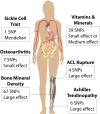Applying personal genetic data to injury risk assessment in athletes
- PMID: 25919592
- PMCID: PMC4412532
- DOI: 10.1371/journal.pone.0122676
Applying personal genetic data to injury risk assessment in athletes
Erratum in
-
Correction: Applying Personal Genetic Data to Injury Risk Assessment in Athletes.PLoS One. 2017 Jan 27;12(1):e0171397. doi: 10.1371/journal.pone.0171397. eCollection 2017. PLoS One. 2017. PMID: 28129391 Free PMC article.
Abstract
Recent studies have identified genetic markers associated with risk for certain sports-related injuries and performance-related conditions, with the hope that these markers could be used by individual athletes to personalize their training and diet regimens. We found that we could greatly expand the knowledge base of sports genetic information by using published data originally found in health and disease studies. For example, the results from large genome-wide association studies for low bone mineral density in elderly women can be re-purposed for low bone mineral density in young endurance athletes. In total, we found 124 single-nucleotide polymorphisms associated with: anterior cruciate ligament tear, Achilles tendon injury, low bone mineral density and stress fracture, osteoarthritis, vitamin/mineral deficiencies, and sickle cell trait. Of these single nucleotide polymorphisms, 91% have not previously been used in sports genetics. We conducted a pilot program on fourteen triathletes using this expanded knowledge base of genetic variants associated with sports injury. These athletes were genotyped and educated about how their individual genetic make-up affected their personal risk profile during an hour-long personal consultation. Overall, participants were favorable of the program, found it informative, and most acted upon their genetic results. This pilot program shows that recent genetic research provides valuable information to help reduce sports injuries and to optimize nutrition. There are many genetic studies for health and disease that can be mined to provide useful information to athletes about their individual risk for relevant injuries.
Conflict of interest statement
Figures


Similar articles
-
No Association Between Risk of Anterior Cruciate Ligament Rupture and Selected Candidate Collagen Gene Variants in Female Elite Athletes From High-Risk Team Sports.Am J Sports Med. 2019 Jan;47(1):52-58. doi: 10.1177/0363546518808467. Epub 2018 Nov 28. Am J Sports Med. 2019. PMID: 30485117
-
Genomic profile in association with sport-type, sex, ethnicity, psychological traits and sport injuries of elite athletes.J Sports Med Phys Fitness. 2022 Mar;62(3):418-434. doi: 10.23736/S0022-4707.21.12020-1. Epub 2021 Mar 5. J Sports Med Phys Fitness. 2022. PMID: 33666074 Review.
-
Balance index score as a predictive factor for lower sports results or anterior cruciate ligament knee injuries in Croatian female athletes--preliminary study.Coll Antropol. 2007 Mar;31(1):253-8. Coll Antropol. 2007. PMID: 17598410
-
American Medical Society for Sports Medicine position statement: concussion in sport.Br J Sports Med. 2013 Jan;47(1):15-26. doi: 10.1136/bjsports-2012-091941. Br J Sports Med. 2013. PMID: 23243113 Review.
-
Reducing the risk of noncontact anterior cruciate ligament injuries in the female athlete.Phys Sportsmed. 2009 Oct;37(3):49-61. doi: 10.3810/psm.2009.10.1729. Phys Sportsmed. 2009. PMID: 20048528 Review.
Cited by
-
Associations between plasma sulfur amino acids and specific fat depots in two independent cohorts: CODAM and The Maastricht Study.Eur J Nutr. 2023 Mar;62(2):891-904. doi: 10.1007/s00394-022-03041-4. Epub 2022 Nov 2. Eur J Nutr. 2023. PMID: 36322288 Free PMC article.
-
COLIA1 + 1245 G > T Sp1 Binding Site Polymorphism is Not Associated with ACL Injury Risks Among Indian Athletes.Indian J Orthop. 2020 Apr 28;54(5):647-654. doi: 10.1007/s43465-020-00119-1. eCollection 2020 Sep. Indian J Orthop. 2020. PMID: 32850029 Free PMC article.
-
Sociability: Comparing the Effect of Chlorpyrifos with Valproic Acid.J Autism Dev Disord. 2025 Mar;55(3):1101-1111. doi: 10.1007/s10803-024-06263-z. Epub 2024 Mar 11. J Autism Dev Disord. 2025. PMID: 38466473 Free PMC article.
-
Perspectives in Sports Genomics.Biomedicines. 2022 Jan 27;10(2):298. doi: 10.3390/biomedicines10020298. Biomedicines. 2022. PMID: 35203507 Free PMC article. Review.
-
Metabolic discrimination of synovial fluid between rheumatoid arthritis and osteoarthritis using gas chromatography/time-of-flight mass spectrometry.Metabolomics. 2022 Jul 4;18(7):48. doi: 10.1007/s11306-022-01893-9. Metabolomics. 2022. PMID: 35781849
References
-
- van Mechelen W. Running injuries. A review of the epidemiological literature. Sports Med. 1992;14: 320–335. - PubMed
-
- O'Toole ML, Hiller WD, Smith RA, Sisk TD. Overuse injuries in ultraendurance triathletes. Am J Sports Med. 1989;17: 514–518. - PubMed
-
- Egermann M, Brocai D, Lill CA, Schmitt H. Analysis of injuries in long-distance triathletes. Int J Sports Med. 2003;24: 271–276. - PubMed
Publication types
MeSH terms
Grants and funding
LinkOut - more resources
Full Text Sources
Other Literature Sources
Medical

